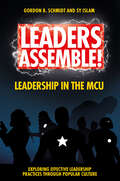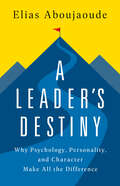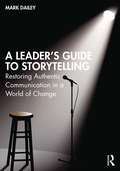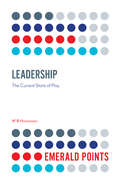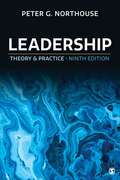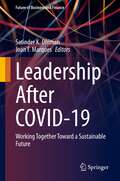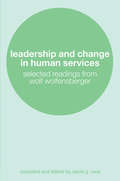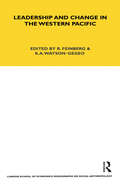- Table View
- List View
Leaders Assemble! Leadership in the MCU (Exploring Effective Leadership Practices through Popular Culture)
by Gordon B. Schmidt Sy IslamIn this volume of Exploring Effective Leadership Practices through Popular Culture, Schmidt and Islam examine how you can learn about research and evidence-based leadership concepts through examples drawn from the popular MCU movies and related superhero films. Leaders Assemble! Leadership in the MCU includes sound research and evidence-based advice on how to improve as a leader on topics such as leadership development, conflict management, mentorship, sensemaking, shared leadership, servant leadership, authentic leadership, servant leadership, and selecting your team. Examples from your favorite MCU films make these concepts come alive so you can easily see how they can be used to improve your own leadership skills. Each chapter focuses on a core leadership concept and shows you how you can use it to be a successful leader, with MCU films and superheroes leading the way with relevant examples, before finally summarizing the main points you can use in your own leadership practice.
Leaders’ Decision Making and Neuroscience: What Are You thinking? (Emerald Points)
by Yinying WangWhat, exactly, is leadership? Leadership is about motivating a group of people to achieve a common goal. Ever since the dawn of the field of leadership, people have craved an understanding of invisible mental processes that underlie visible behavior. Why do people behave the way they do? Where does behavior come from? Consider your brain is a decision-making organ. Without the brain, you are unable to make decisions. You will learn how power, emotions, attention, memory, personality, and gut feeling influence your decisions. You will learn neural constraints imposed on your decision making and how to address them. In addition to learning how to make high-quality individual decisions, you will learn how to ensure a group makes high-quality decisions collectively. How does a collective mind emerge from multiple minds when making collective decisions? What should leaders do to facilitate a group decision-making process that generates collective wisdom, instead of the madness of crowds? If you are a leader, or aspire to be a leader, who strives to make high-quality decisions, this is the book for you. Leaders’ Decision Making and Neuroscience will take you on a journey of how a decision is made in your brain from a perspective of neuroscience and provides incredible insight into the nature of how the brain and nervous systems work in relation to decision making.
Leaders’ Decision Making and Neuroscience: What Are You thinking? (Emerald Points)
by Yinying WangWhat, exactly, is leadership? Leadership is about motivating a group of people to achieve a common goal. Ever since the dawn of the field of leadership, people have craved an understanding of invisible mental processes that underlie visible behavior. Why do people behave the way they do? Where does behavior come from? Consider your brain is a decision-making organ. Without the brain, you are unable to make decisions. You will learn how power, emotions, attention, memory, personality, and gut feeling influence your decisions. You will learn neural constraints imposed on your decision making and how to address them. In addition to learning how to make high-quality individual decisions, you will learn how to ensure a group makes high-quality decisions collectively. How does a collective mind emerge from multiple minds when making collective decisions? What should leaders do to facilitate a group decision-making process that generates collective wisdom, instead of the madness of crowds? If you are a leader, or aspire to be a leader, who strives to make high-quality decisions, this is the book for you. Leaders’ Decision Making and Neuroscience will take you on a journey of how a decision is made in your brain from a perspective of neuroscience and provides incredible insight into the nature of how the brain and nervous systems work in relation to decision making.
A Leader's Destiny: Why Psychology, Personality, and Character Make All the Difference
by Elias AboujaoudeA psychiatrist puts leadership &“on the couch,&” with a provocative exploration of its crucial, often ignored, psychological and personal character foundations. Elias Aboujaoude&’s distinctive exploration of leadership explains how our cultlike obsession with leadership gives narcissists and sociopaths an edge and results in leadership failure everywhere we look—and how resisting the imperative to rise at all costs leaves many with an inferiority complex. His takedown of the leadership industrial complex pokes a very sharp elbow into an industry seemingly united in a modern form of alchemy to create leadership gold—a waste of time and money, Aboujaoude vividly illustrates, since leaders emerge from a unique combination of personal, psychological, and situational factors that cannot be easily controlled or manipulated, no matter how gifted the executive coach. This bracing take on a classic subject provides new insight into the way psychology aligns with the requirements of effective and happy leadership. The result is to empower us to understand ourselves and step up if we have what it takes to lead—or find equally rewarding, often superior, ways to achieve fulfillment if we don&’t.
Leaders Eat Last: Why Some Teams Pull Together and Others Don't
by Simon SinekSimon Sinek's recent video on 'The Millennial Question' went viral with over 150 million views. In Leaders Eat Last, Sinek explores how leaders can inspire cooperation and change, and focuses on the millennial generation in the workplace. Imagine a world where almost everyone wakes up inspired to go to work. This is not a crazy, idealised notion. In many successful organisations, great leaders are creating environments in which teams trust each other so deeply that they would put their lives on the line for each other. Yet other teams, no matter what incentives were offered, are doomed to infighting, fragmentation and failure. Why?Today's workplaces tend to be full of cynicism, paranoia and self-interest. But the best organisations foster trust and cooperation because their leaders build what Sinek calls a Circle of Safety. It separates the security inside the team from the challenges outside. Everyone feels they belong and all energies are devoted to facing the common enemy and seizing big opportunities.As in Start with Why, Sinek illustrates his ideas with fascinating true stories, from the military to manufacturing, from government to investment banking. He shows that leaders who are willing to eat last are rewarded with deeply loyal colleagues who will stop at nothing to advance their vision. It's amazing how well it works.
Leaders for Tomorrow: Challenges for Military Leadership in the Age of Asymmetric Warfare (Advanced Sciences and Technologies for Security Applications)
by Marina Nuciari Eraldo OlivettaSince the end of bipolarism, the concept of asymmetric warfare, and of asymmetric conflict in general, has been increasingly applied with regard to armed forces activities and tasks. This book presents the findings of comparative empirical research conducted in selected military units by a group of distinguished experts on military organization, who hail from the eight participating countries: Bulgaria, Cameroon, Denmark, Finland, Italy, Lithuania, the Philippines and Spain.It discusses remarks made by military leaders with extensive experience in the field regarding current doctrines on military leadership and their applicability in the field, as well as proposals and suggestions for new directions.“It is a complex relation, always based on respect and politeness, but often with mismatched interests.” (Army Colonel).“It makes you realize that there is a cultural gap. You must firstly understand who you are going to relate to, and the culture of these people, and then try to establish a certain kind of relationship. Often the platoon commander states his objective and must try to establish a relationship, contact with the village chief.” (Army Lieutenant, Platoon Commander).“[In Afghanistan] We had meals with the locals, sometimes the food didn’t taste good, but you had to eat it if you wanted to be welcomed back again” (Army Captain, Company Commander).These are just some of the many voices stemming from the ground in diverse international asymmetric conflict theatres (in Iraq, in Kosovo, in Afghanistan…), comments by military officers, commanders at different hierarchical levels, asked to reflect on their experiences as military leaders in crisis response operations.Military professionals, and military leaders in particular, perceive themselves as facing ambiguous situations that require an update in their professional training, and new skills to confront unexpected and unpredictable factors. Drawing on lived experiences, the book offers insights into what a new kind of leadership means when leaders have to cope with diverse and unclear missions. It also addresses leadership styles and behaviours, as well as individual adaptive behaviours on the part of military leaders, with special reference to middle and middle-high level ranks, such as captains, majors and colonels.Given its scope, the book will appeal not only to military professionals and military affairs scholars and experts, but also to readers interested in gaining a better understanding of the challenges that international expeditionary units are facing in crisis areas around the globe.
A Leader’s Guide to Designing High Performing Quality Management Systems: The 7 Keys that Solve, Achieve, Sustain, and Transform Organizational Outcomes in High-Risk Environments
by Casey J. BedgoodThe genesis of this book is over two decades of experience working with leaders who struggle with the concept of Quality Management System (QMS). Often, leaders fail to understand this concept, implement ineffective QMS models and subsequently are disrupted from their roles. More important and even more impactful are the consequences a poorly designed and executed QMS model has on organizational stakeholders including customers.The purpose of this book is to provide a simple leadership quick guide for designing high-performing Quality Management System models. This guide will focus on Quality Management System assessment, structure, process and achieving outcomes through practical real-world tools, templates, and models. The test of any model is its outcomes. This book will provide decades of insight so leaders ensure their QMS model Solves Problems, Achieves Outcomes, Sustains Wins, and Transforms Organizational Outcomes in High-Risk Environments.The intended audience for this book includes but is not limited to: top executives, governance members, leaders of any rank, thought leaders, strategists, students, performance improvement leaders, change agents, teachers, and anyone interested in quality, improvement, strategy, and leadership. Regardless of role, organization type, or industry, quality matters and is a focal point for customers. Thus, those leading the charge for excellence in this arena must have a good structure, process, and measurable outcomes sustained over time.So, why is this topic important? In today’s world, change is the new normal and only constant. In many industries, such as healthcare for example, the foundations of the industries themselves are shaking greater than at any other time in history. As change grows, so does the associated risk and disruption. How will leaders and their organizations succeed in high-risk environments without a good foundation? The short answer is they won’t. The starting point for success is the Quality Management System.By reading this book, readers will learn: How to construct a well-defined Quality Management System (QMS) How to identify and counter common misperceptions of QMS Techniques to engage other leaders in crucial conversations related to QMS gaps, illusions of success, perceived and real shortcomings, and measures of success How to conduct a basic and advanced assessment of Quality Management System models to determine what is working, what is not working, and high-risk areas to improve The required structural elements of high-performing QMS models A wholistic approach to the QMS process What measures constitute QMS success
A Leader’s Guide to Designing High Performing Quality Management Systems: The 7 Keys that Solve, Achieve, Sustain, and Transform Organizational Outcomes in High-Risk Environments
by Casey J. BedgoodThe genesis of this book is over two decades of experience working with leaders who struggle with the concept of Quality Management System (QMS). Often, leaders fail to understand this concept, implement ineffective QMS models and subsequently are disrupted from their roles. More important and even more impactful are the consequences a poorly designed and executed QMS model has on organizational stakeholders including customers.The purpose of this book is to provide a simple leadership quick guide for designing high-performing Quality Management System models. This guide will focus on Quality Management System assessment, structure, process and achieving outcomes through practical real-world tools, templates, and models. The test of any model is its outcomes. This book will provide decades of insight so leaders ensure their QMS model Solves Problems, Achieves Outcomes, Sustains Wins, and Transforms Organizational Outcomes in High-Risk Environments.The intended audience for this book includes but is not limited to: top executives, governance members, leaders of any rank, thought leaders, strategists, students, performance improvement leaders, change agents, teachers, and anyone interested in quality, improvement, strategy, and leadership. Regardless of role, organization type, or industry, quality matters and is a focal point for customers. Thus, those leading the charge for excellence in this arena must have a good structure, process, and measurable outcomes sustained over time.So, why is this topic important? In today’s world, change is the new normal and only constant. In many industries, such as healthcare for example, the foundations of the industries themselves are shaking greater than at any other time in history. As change grows, so does the associated risk and disruption. How will leaders and their organizations succeed in high-risk environments without a good foundation? The short answer is they won’t. The starting point for success is the Quality Management System.By reading this book, readers will learn: How to construct a well-defined Quality Management System (QMS) How to identify and counter common misperceptions of QMS Techniques to engage other leaders in crucial conversations related to QMS gaps, illusions of success, perceived and real shortcomings, and measures of success How to conduct a basic and advanced assessment of Quality Management System models to determine what is working, what is not working, and high-risk areas to improve The required structural elements of high-performing QMS models A wholistic approach to the QMS process What measures constitute QMS success
A Leader’s Guide to Storytelling: Restoring Authentic Communication in a World of Change
by Mark DaileyPart manual, part memoir and part call to action, this book demonstrates why the core skill needed by leaders in the next decade and into the future will be authentic and effective communication. Communications based on character, integrity and values will be critical in helping leaders navigate the two mega trends of accelerated technological change and increasing demands for social change. This book is the first to marry practical advice on deepening communication skills with insight from a coaching and cognitive point of view into what techniques works and why, and to pull together the wider societal issues and the operating context for leaders. Counter-intuitive and written to provoke thought and awareness, the author looks at the psychological and emotional effects of our communications and what leaders can do to inspire and engage, guiding them through three sections: • A framework for effective communications • A toolkit, detailing what good looks like in practical situations • The authentic leader, an exploration of the changing communications landscape and why a different kind of leadership is needed C-suite executives, leaders about to take that last step into the C-suite or millennial leaders about to enter the boardroom will value this book as an advisory guide, as a handbook to be used in internal coaching and training sessions and as a manual and aide memoir for themselves.
A Leader’s Guide to Storytelling: Restoring Authentic Communication in a World of Change
by Mark DaileyPart manual, part memoir and part call to action, this book demonstrates why the core skill needed by leaders in the next decade and into the future will be authentic and effective communication. Communications based on character, integrity and values will be critical in helping leaders navigate the two mega trends of accelerated technological change and increasing demands for social change. This book is the first to marry practical advice on deepening communication skills with insight from a coaching and cognitive point of view into what techniques works and why, and to pull together the wider societal issues and the operating context for leaders. Counter-intuitive and written to provoke thought and awareness, the author looks at the psychological and emotional effects of our communications and what leaders can do to inspire and engage, guiding them through three sections: • A framework for effective communications • A toolkit, detailing what good looks like in practical situations • The authentic leader, an exploration of the changing communications landscape and why a different kind of leadership is needed C-suite executives, leaders about to take that last step into the C-suite or millennial leaders about to enter the boardroom will value this book as an advisory guide, as a handbook to be used in internal coaching and training sessions and as a manual and aide memoir for themselves.
Leaders in Computing: Changing the digital world (Ebo Ser.)
by Linus Torvalds Steve Wozniak Vint Cerf Grady Booch Dame Stephanie Shirley Professor Donald Knuth Professor Karen Spärck Jones Sir Tim Berners-Lee Jimmy WalesThis collection of exclusive interviews provides a fascinating insight into the thoughts and ideas of influential figures from the world of IT and computing, including Sir Tim Berners-Lee, Donald Knuth, Linus Torvalds, Jimmy Wales, Grady Booch, Steve Wozniak, Vint Cerf, Karen Spärck Jones and Dame Stephanie Shirley. With representatives from areas as diverse as programming, development, hardware, networks, interface, internet and applications, this collection also provides an excellent overview of important developments in this diverse field over recent years.
Leaders in Computing: Changing the digital world (Ebo Ser.)
by Linus Torvalds Steve Wozniak Vint Cerf Grady Booch Dame Stephanie Shirley Professor Donald Knuth Professor Karen Spärck Jones Sir Tim Berners-Lee Jimmy WalesThis collection of exclusive interviews provides a fascinating insight into the thoughts and ideas of influential figures from the world of IT and computing, including Sir Tim Berners-Lee, Donald Knuth, Linus Torvalds, Jimmy Wales, Grady Booch, Steve Wozniak, Vint Cerf, Karen Spärck Jones and Dame Stephanie Shirley. With representatives from areas as diverse as programming, development, hardware, networks, interface, internet and applications, this collection also provides an excellent overview of important developments in this diverse field over recent years.
Leadership: The Current State of Play (Emerald Points)
by W. B. HowiesonLeadership: The Current State of Play defines contemporary thinking in leadership from both academic and practitioner perspectives. It presents an easy-to-read overview of historical and contemporary thought on the roles and functions of leaders and applies these perspectives to problems in the present day. This book offers insights for professionals in organisational leadership positions in a variety of sectors in the UK and beyond. It is also of great interest to researchers and students in the fields of business and management. Across the study’s four chapters, there are nine vignettes written by leading practitioners of organisational leadership in various fields, including clinical dentistry, the Ministry of Defence, charities and football management. These vignettes offer a unique opportunity to hear the voices of individuals who are rarely considered in such leadership literature. Their reflections illustrate the benefit of approaching leadership through the eyes of those practicing it.
Leadership: The Current State of Play (Emerald Points)
by W. B. HowiesonLeadership: The Current State of Play defines contemporary thinking in leadership from both academic and practitioner perspectives. It presents an easy-to-read overview of historical and contemporary thought on the roles and functions of leaders and applies these perspectives to problems in the present day. This book offers insights for professionals in organisational leadership positions in a variety of sectors in the UK and beyond. It is also of great interest to researchers and students in the fields of business and management. Across the study’s four chapters, there are nine vignettes written by leading practitioners of organisational leadership in various fields, including clinical dentistry, the Ministry of Defence, charities and football management. These vignettes offer a unique opportunity to hear the voices of individuals who are rarely considered in such leadership literature. Their reflections illustrate the benefit of approaching leadership through the eyes of those practicing it.
Leadership: Theory And Practice (PDF)
by Peter G. NorthouseThe market-leading Leadership: Theory and Practice presents an academically robust account of the major theories and models of leadership with a focus on how theory can inform practice. Author Peter G. Northouse uses a consistent structure for each chapter that allows readers to easily compare and contrast different theories. Case studies and questionnaires provide students with practical examples and opportunities to deepen their understanding of their own leadership style. The fully updated Ninth Edition features a new chapter on inclusive leadership, 17 new real-world cases that profile leaders from across the globe, a new discussion on leadership and morality, and examples of timely issues such as leadership during the COVID-19 pandemic.
Leadership: Theory And Practice
by Peter G. Northouse"Now with a new chapter on Inclusive Leadership Adopted in thousands of courses in 89 countries and translated into 15 different languages, this market-leading text successfully combines an academically robust account of the major theories and models of leadership with an accessible style and focus on how leadership theory can inform leadership practice. Peter G. Northouse uses a consistent structure for each chapter, allowing readers to easily compare and contrast different theories. Case studies and questionnaires provide students with practical examples and opportunities to deepen their understanding of their own leadership style. Key Features: A consistent chapter structure outlines each approach, how it works, and the major studies behind it, followed by an analysis of the strengths and criticisms for each approach Three case studies in each chapter help students to apply leadership theories in real-world scenarios. Questionnaires
Leadership: A Critical Text (PDF)
by Simon Western`It is refreshing when you come across a clear, well-written book about leadership that is not peddling the latest gimmick, buzzword or quick fix. What makes this work really refreshing is the emphasis on the critical dimension in the title and the breadth of the author's own experience of work' - Times Higher Education `An excellent resource for examining and analyzing leadership from different perspectives' - New Horizons in Adult Education and Human Resource Development `In a highly original way, taking "Critical Theory" as a point of departure, Dr Western helps us to obtain greater insight into the enigma of leadership' - Manfred Kets de Vries `One of the "most promising" forthcoming management books for 2007' - European Academy of Management (EURAM) `Leadership A Critical Text is an outstanding addition to the Leadership literature. This is an excellent text which takes the field to new heights in the first decade of the 21st Century' - Professor Cary L. Cooper, CBE, Professor of Organizational Psychology and Health at Lancaster University `The book provides a unique and much needed 'voice' to the field of leadership studies, and will have a significant impact worldwide' - Professor Jonathan Gosling, Director of the Leadership Centre Exeter University Providing a critical review and analysis of the key debates within leadership, this book challenges the notion of the individual or hero leader. The author develops the idea of leadership as a distributed process between lots of agents in an organization. In doing so he provides a new framework which readers can use to understand and implement this distributed type of leadership. Chapters include vignettes and case studies to support readers' understanding of ideas, and pedagogical features emphasize core learning points. To aid course tutors a teaching guide to accompany the book is available online from here The author's own website can be found here
Leadership 4.0 – Effektive Führung in der Arbeit 4.0: Manual (SpringerTests)
by Julia Nogga Jens RowoldWie können Führungskräfte in der digitalen Arbeitswelt ihre Mitarbeitenden bzw. Arbeitsteams motivieren und an die Organisation binden? Welche führungsbezogenen Verhaltensweisen sind dabei unverzichtbar? Welche Instrumente können Personaler*innen nutzen, um Führungskräfte auf die neuen Herausforderungen der Arbeitswelt 4.0 vorzubereiten? Hier erhalten Sie den ersten Fragebogen der Führungsverhalten in digitaler Umgebung messen kann.Wie von der Praxis benötigt, kombiniert dieses Modell eine Vielzahl effektiver Verhaltensweisen, woraus ein neuer Führungsstil entsteht. Dieser beinhaltet dabei vier Facetten von Verhaltensweisen, die nachgewiesenermaßen relevant für den Erfolg von Führungskräften und ihre jeweilige Organisation sind.Dazu zählen:a) die Partizipationb) die Arbeitsgestaltung (räumliche, zeitliche und technologisch)c) die individuelle Entwicklungd) die TeamentwicklungDie vier Facetten von bilden eine angemessene Grundlage, aktuelle Aufgaben und Probleme der organisationalen Praxis zu bewältigen. Durch die veränderten Arbeitsbedingungen der Arbeit 4.0 ergeben sich zahlreiche Herausforderungen, mit denen Führungskräfte in Unternehmen konfrontiert sind. Die Grenzen zwischen Erwerbsarbeit und privatem Freizeitbereich verwischen zunehmend, sodass Mitarbeitende einerseits mehr Partizipation, andererseits mehr subjektiv erlebte Relevanz in ihrem Job erleben möchten. Deswegen müssen Führungskräfte ihren Mitarbeitenden die Möglichkeit geben, sich an Entscheidungen im Unternehmen zu beteiligen. Dies kann erfolgen, indem Führungskräfte ihren Mitarbeitenden ermöglichen, Einfluss auf Arbeitsinhalte zu nehmen oder Prozessinnovationen anzustoßen.Da ein Fachkräftemangel auf dem Arbeitsmarkt herrscht, steigt die Bedeutung, kompetente Mitarbeitende im Unternehmen zu halten. Wenn es darum geht, die emotionale Verbundenheit der Mitarbeitenden mit dem Unternehmen zu fördern, spielen Führungskräfte eine wichtige Rolle. Dass Führungskräfte dieses affektive Commitment bei den Mitarbeitenden hervorbringen können, ist von empirischen Studien belegt. Diesbezüglich ist auch die Arbeitszufriedenheit der Mitarbeitenden von Relevanz, denn viele Studien bestätigen den Zusammenhang von Führung und Arbeitszufriedenheit.
Leadership Accountability in a Globalizing World
by C. WilliamsLeadership accountability - for violence, corruption and environmental harm - is a new aspect of globalization and civil society. This innovative forward-looking analysis explains how 'cumulative lock-in' fuels leadership deceit. The lessons are for those learning to be, or learning to question, leaders.
Leadership after COVID-19: Working Together Toward a Sustainable Future (Future of Business and Finance)
by Satinder K. Dhiman Joan F. MarquesThe COVID-19 pandemic has permanently changed lives around the world and no dimension of life and leadership seems to have been spared from its wrath. It has also stirred us into thinking about novel approaches to lead organizations and societies toward a shared, sustainable future. This book offers novel perspectives on leadership and change management after the COVID-19 pandemic that take us beyond striving for thriving—perspectives that are grounded in emergent theory, research and practice. It highlights sustainable leadership and change management strategies to effectively deal with unpredictable and rapidly changing situations—particularly in a world that is increasingly volatile, uncertain, complex, and ambiguous (VUCA). This book also highlights engaging perspectives by specialists from different disciplines such as business, psychology, education, and health care. It serves as a practical guide in identifying and responding to leadership challenges and opportunities in each of the four VUCA categories of volatility, uncertainty, complexity, and ambiguity—and how they affect businesses, organizations, and societies as a whole.
Leadership Agility: Developing Your Repertoire of Leadership Styles
by Ron Meyer Ronald MeijersLeadership is about influencing others to move in a certain direction and there are many ways of achieving this influence. Each of these leadership styles has its inherent qualities and pitfalls, and will be more suited to specific people and different circumstances. The more leaders understand their preferred leadership styles and are able to flexibly switch to the most suitable style given the situation, the more effective they will be. This book maps out ten sets of opposite leadership styles, giving readers the possibility to understand the strengths and weaknesses of both sides, and to identify their own current preference. The ten leadership style dimensions cover the full range of leadership roles, from the leader as coach (interpersonal leadership), to the leader as organizer (organizational leadership), as strategist (strategic leadership), as sense-maker (leadership and mission) and as role model (leadership and self). Readers are invited to draw up their own leadership development plans, which is supported by an interactive App. Readers are also challenged to reflect on how they would approach a number of cases, after which they can go to an interactive web-forum to read how others have responded and engage in a discussion with them. Leadership Agility is a useful tool for practitioners in the corporate world as well as business students and emerging leaders.
Leadership Agility: Developing Your Repertoire of Leadership Styles
by Ron Meyer Ronald MeijersLeadership is about influencing others to move in a certain direction and there are many ways of achieving this influence. Each of these leadership styles has its inherent qualities and pitfalls, and will be more suited to specific people and different circumstances. The more leaders understand their preferred leadership styles and are able to flexibly switch to the most suitable style given the situation, the more effective they will be. This book maps out ten sets of opposite leadership styles, giving readers the possibility to understand the strengths and weaknesses of both sides, and to identify their own current preference. The ten leadership style dimensions cover the full range of leadership roles, from the leader as coach (interpersonal leadership), to the leader as organizer (organizational leadership), as strategist (strategic leadership), as sense-maker (leadership and mission) and as role model (leadership and self). Readers are invited to draw up their own leadership development plans, which is supported by an interactive App. Readers are also challenged to reflect on how they would approach a number of cases, after which they can go to an interactive web-forum to read how others have responded and engage in a discussion with them. Leadership Agility is a useful tool for practitioners in the corporate world as well as business students and emerging leaders.
Leadership and Change in Human Services: Selected Readings from Wolf Wolfensberger
by David RaceFor over forty years Wolf Wolfensberger has been a significant figure in the world of human services, especially in the field of learning disability. His work on normalization and citizen advocacy in the late 1960s and early 1970s has been acknowledged by supporters and critics alike to have been fundamental to developments in a number of countries, most notably his adopted country, and the USA, Canada, Australasia, and the UK. His further work in developing the theory of social role valorization, the successor to normalisation, and as a commentator on broader trends in society and their effects on vulnerable people and services for them has ensured his place as a major voice for values and the human worth of all people. Never afraid of controversy, his views have brought him into conflict with institutional vested interests and radical groups alike.In Leadership and Change in Human Services David Race introduces the reader to Wolfensberger's key ideas through a series of extracts, with commentary, from his published work. Throughout the edited selection, the emphasis is on placing Wolfensburger's work in contemporary context and examining its continuing relevance today. Including a comprehensive bibliography of Wolfensburger's written output, this text offers an invaluable source of reference to all those concerned with the recent history of the human services.
Leadership and Change in Human Services: Selected Readings from Wolf Wolfensberger
by David G. RaceFor over forty years Wolf Wolfensberger has been a significant figure in the world of human services, especially in the field of learning disability. His work on normalization and citizen advocacy in the late 1960s and early 1970s has been acknowledged by supporters and critics alike to have been fundamental to developments in a number of countries, most notably his adopted country, and the USA, Canada, Australasia, and the UK. His further work in developing the theory of social role valorization, the successor to normalisation, and as a commentator on broader trends in society and their effects on vulnerable people and services for them has ensured his place as a major voice for values and the human worth of all people. Never afraid of controversy, his views have brought him into conflict with institutional vested interests and radical groups alike.In Leadership and Change in Human Services David Race introduces the reader to Wolfensberger's key ideas through a series of extracts, with commentary, from his published work. Throughout the edited selection, the emphasis is on placing Wolfensburger's work in contemporary context and examining its continuing relevance today. Including a comprehensive bibliography of Wolfensburger's written output, this text offers an invaluable source of reference to all those concerned with the recent history of the human services.
Leadership and Change in the Western Pacific
by R. Feinberg K. A. Watson-GregeoAn ethnographic exploration of the rise of new forms of leadership at community and national levels with islanders are synthesising traditional and Western models.
